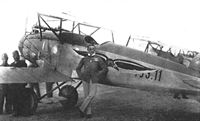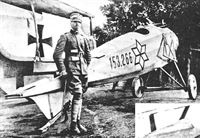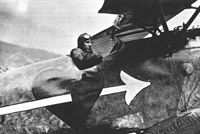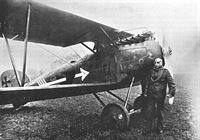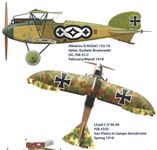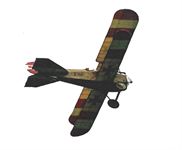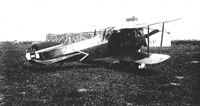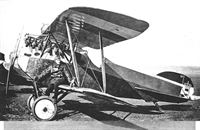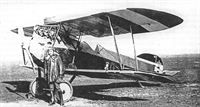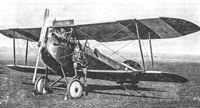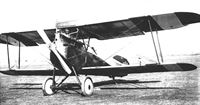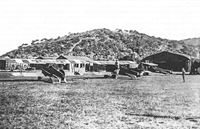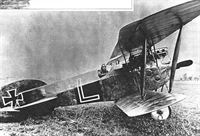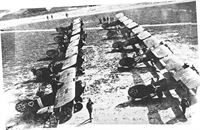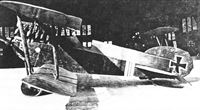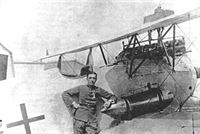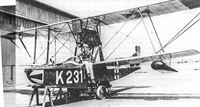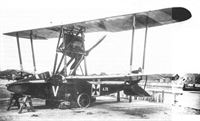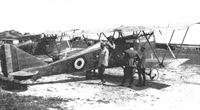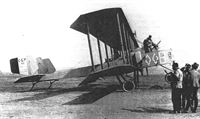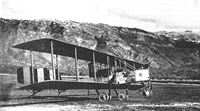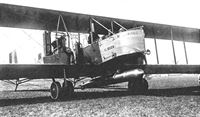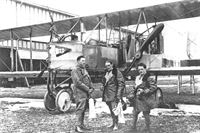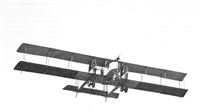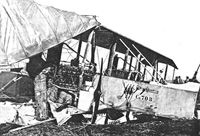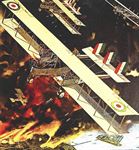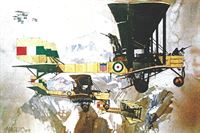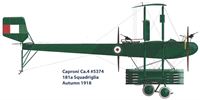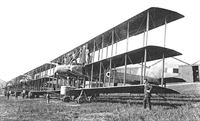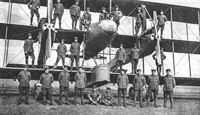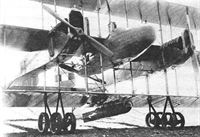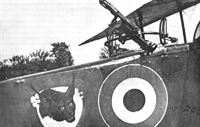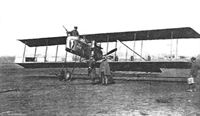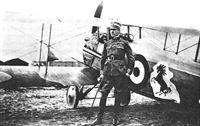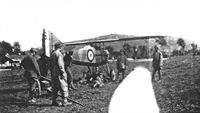Книги
Centennial Perspective
J.Davilla
Italian Aviation in the First World War. Vol.1: Operations
203
J.Davilla - Italian Aviation in the First World War. Vol.1: Operations /Centennial Perspective/ (73)
Albatros D.III(Oef) 253.116, Oblt. Friedrich Navratil, OC, Flik 3/J, Romagnano Aerodrome, August 1918
Oberleutnant Frank Linke-Crawford used Albatros D.III 153.11 from August to December 1917. On 26 December Zugsfuhrer Alfred Brand crash-landed this plane near Fener after a combat with Sergente Ennio Sorrentino of 81a Squadriglia. Austrian-built Albatros fighters were more robust than the German originals. (Carlo Lucchini)
Frank Linke-Crawford alongside his Albatros DIII serving with Fliegerkompanie 41J at Sesana, October 1917. This Austrian ace scored 27 confirmed victories before being killed in action on 31 July 1918.
Frank Linke-Crawford alongside his Albatros DIII serving with Fliegerkompanie 41J at Sesana, October 1917. This Austrian ace scored 27 confirmed victories before being killed in action on 31 July 1918.
Numbed with cold, Italian soldiers walk near Albatros and Phonix fighters lined up on Bressanone airfield in a foggy November day, after the end of the war. (Aeronautica Militare)
Baracca poses by his 34th and final victory, Albatros D.III 153.266. Its pilot, Ltn. Von Josipovich, survived and was captured. Baracca was well known for his chivalry and his habit of visiting downed airmen and bringing them small gifts to ease their captivity. A short four days later, Baracca himself would be shot down and killed.
"Оэффаг" серии 253. Пилот - лейтенант Навратил
Albatros D.III(Oef) 253.116 (253.06 ???), carrying the markings of Oberleutnant Friedrich Navratil of Flik 3/J, was flown by Zugsfuhrer Adolf Blaha from Innsbruck to Switzerland on 11 November 1918. After being interned for a year, Blaha was permitted to fly to Czechoslovakia on 3 November 1919. The armament has been removed but the blast tubes remain in place.
Albatros D.III(Oef) 253.116 (253.06 ???), carrying the markings of Oberleutnant Friedrich Navratil of Flik 3/J, was flown by Zugsfuhrer Adolf Blaha from Innsbruck to Switzerland on 11 November 1918. After being interned for a year, Blaha was permitted to fly to Czechoslovakia on 3 November 1919. The armament has been removed but the blast tubes remain in place.
Rampante! by Russell Smith shows leading Italian ace Francesco Baracca scoring his 34th and final victory while flying his Spad 13 three days before his death. After the war Baracca’s prancing horse insignia was adopted by Enzo Ferrari for his race cars.
The (Berg) C.I was a fast two-seat reconnaissance airplane little larger than its D.I fighter stablemate.
The Aviatik (Berg) C.I was one of the primary two-seat reconnaissance airplanes used by the Austro-Hungarian Empire. It was fast but fragile. The pilot's gun was fixed to fire over the propeller arc due to Austria's shortage of synchronizing gear.
Flik 1/J's CO Oblt Bela Macourek at Igalo with Aviatik D.I 338.02. A five-victory ace, Macourek's victory tally included three British aircraft.
Flik 6/F aircraft lined up in an unknown LFT airfield in 1918. In the photograph, OffStv Julius Arigi (right) and Hptm Josef Bendik (left) are talking behind Aviatik D.Is 284.13 and 338.02, the two aircraft nearest to the camera. The presence of Arigi (and of 338.02) may indicate that Flik 1/J fighters are present too. Petr Aharon Tesar
Etrich Taube in Libya with Giulio Gavotti who on November 1, 1911 dropped three small bombs over Turkish encampments, the first aerial bombardment in history. (Roberto Gentilli)
The Lloyd C.V was more advanced, powerful design than its predecessors and served in larger numbers due to its much better speed. Its complex, veneer-surfaced wing was robust but very difficult to repair if damaged. First of the series was 46.01 shown here.
The Lloyd 40.11 prototype was later re-designated C.V 46.01 as shown here. Originally the 40.11 was tested with an unbalanced rudder.
Lloyd C.V 46.01 in Aspern, Einfliegerei, Herbst 1917, Rückansicht; deutlich sind die Fourniertragflächen zu erkennen
Lloyd C.V 46.01 в Асперне, осень 1917 года; Хорошо видны полосы шпона в конструкции крыльев (Fourniertragflächen).
The Lloyd 40.11 prototype was later re-designated C.V 46.01 as shown here. Originally the 40.11 was tested with an unbalanced rudder.
Lloyd C.V 46.01 in Aspern, Einfliegerei, Herbst 1917, Rückansicht; deutlich sind die Fourniertragflächen zu erkennen
Lloyd C.V 46.01 в Асперне, осень 1917 года; Хорошо видны полосы шпона в конструкции крыльев (Fourniertragflächen).
Lohner L127 in the museum wears the name MANI on its nose above the national insignia. The national insignia painted on the nose to be viewed from in front if the aircraft was started by the Austrians and adapted by Italy.
Banfield posing beside his L16 fighter aircraft, the first specialized fighter aircraft in the entire Austro-Hungarian military. Banfield was flying this aircraft on 6th August 1916 when he downed Caproni 1134.
Closeup of Lohner L47. These flying boats had an insignia on the nose in addition to the normal locations.
Phonix C.I 121.17, Oblt. Arnold Barwig & Zugsfuhrer Max Kauer. This crew in this aircraft were credited by the Austrians with downing Francesco Baracca.
Phonix C.I 121.02 shows the unique tail design that gave observers in this type such a wide field of fire. The Phonix C.I was also fast, tough, and maneuverable.
Phonix C.I, 121.02, Aspen, im Oktober 1917 abgesturzt.
Phoenix C.I, 121.02, Аспен, разбился в октябре 1917 года.
Phonix C.I, 121.02, Aspen, im Oktober 1917 abgesturzt.
Phoenix C.I, 121.02, Аспен, разбился в октябре 1917 года.
Like many events in the air war, there is more than one version of the demise of Maggiore Baracca. He was also claimed by the crew of Oblt. Arnold Barwig and Zugsfuhrer Max Kauer in Phonix C.I 121.17 pictured here. Although a reconnaissance pilot, Kauer achieved a total of four victories in this aircraft. Which version of the story is true may never be known for certain. In any case, a well-flown two-seater was a tough opponent for any fighter pilot, and the Phonix C.I was the best Austro-Hungarian reconnaissance airplane.
Wollemann returned to duty with his Phonix D.I, A97. The Phonix fighter family was an important series for the Austro-Hungarian Army Air Service and the Navy purchased twenty D.I fighters in two batches, A.97 - A.104 (later serialized as J.1 - J.8) and A.107 - A.117 later serialized as J.9 - J.20). The Phonix D.I fighters supplied to the k.u.k. Kriegsmarine were powered by 230 hp Hiero engines and had two synchronized machine guns.
Abwehrflugzeug A.97, Type Phönix D.I, Alturafeld bei Pola, Oktober 1917, am Flügel sitzend Frglt Stephan Wollemann
Abwehrflugzeug A.97, Type Phönix D.I, Alturafeld bei Pola, Oktober 1917, am Flügel sitzend Frglt Stephan Wollemann
Frglt. Wollemann posed by his Phonix D.I fighter, A97, when he was a member of the defense flight for the naval facilities at Pola, located at Altura airfield in 1918.
The initial equipment of Abwehrflugstation Igalo consisted of Phonix D.Is, the majority (if not all) of which were fitted with 230-hp Hiero engines. Here, a Phonix D.I of the SFW is seen at Abwehrflugstation Altura, near Pola. The paint scheme of the naval Phonix D.Is was somewhat original, with a beautiful chromatic effect that is very popular among today's aircraft modelers. The wing tips and tail surfaces sported the red-white-red stripes of the k.u.k. Kriegsmarine's flag, while the fuselage was splotched with a brownish paint. This 'camouflage' - or rather, 'anti-camouflage' - scheme generated a chromatic resemblance to the flying boats of the SFW, which made it easier to identify the nationality of the aircraft when it was airborne. Unfortunately, no photographs of Phonix D.IIa's in naval service have been found. It is possible that their paint scheme was in accordance with the regulation change issued in July 1918, which provided that the fighters had an overall paint of light grey, with the stripes of the naval flag confined to the rudder. Andreas Handel
Phonix D.I in k.u.k. Kriegsmarine markings of red/white/red wingtips and vertical tail and iron cross national insignia.
The defensive flight of naval Phonix D.I fighters based at Altura airfield and charged with the defense of the naval base at Pola.
Phonix fighters of Flik 55J sunbathe on Pergine airfield on 24th July 1918 waiting for an inspection. Kasza has added a red heart on the tail of his plane as a gesture of morning for his fallen friend. Phonix fighters were very robust, had good handling qualities, and mounted two synchronized machine guns. (Gregory VanWyngarden)
A colorful medley of Phonix D.II and D.IIa fighters of Flik 55/J lined up at Pergine in the summer of 1918. The radiator of the D.II in the front left row has been removed.
A colorful medley of Phonix D.II and D.IIa fighters of Flik 55/J lined up at Pergine in the summer of 1918. The radiator of the D.II in the front left row has been removed.
Three white stripes identify Phonix D.IIa 422.14 flown by Zugsfuhrer Alexander Kasza. On this plane he obtained one victory, shooting down British Bristol F2b C4700 on 9th June 1918. (Gregory VanWyngarden)
Phonix D.III J.31, one of two delivered before the Armistice. Considered by authoritative historians as the most advanced fighter built in the Dual Monarchy, these machines had ailerons on all four wings, a revised wing layout, and the machine guns mounted at eye level and within arms' reach. The k.u.k. Kriegsmarine ordered 40 Phonix D.IIIs for its Abwehrflugstationen. These were to receive codes from 'J.31' to 'J.70'. However, only 'J.31' and 'J.32' reached the SFW units before the war's end. Photographs show 'J.31' and 'J.32' fitted with auxiliary fuel tanks mounted close to the lower wing roots. The extra fuel contained in the tanks would have allowed for a very long pursuit of Allied aircraft. Note the light grey paint scheme in use with the SFW by the war's end. Aaron Weaver/ Jack Herris
Numbed with cold, Italian soldiers walk near Albatros and Phonix fighters lined up on Bressanone airfield in a foggy November day, after the end of the war. (Aeronautica Militare)
The speedy UFAG C.I was one of the two-seaters intended to replace the Brandenburg C.I. This example lost fabric from its top wing during flight; the fortunate crew is shown with it. This incident shows why the sturdy Brandenburg was produced in such great numbers and appreciated by its crews.
SS-4 was one of the six Sea Scout airships sold to Italy by the Admiralty. It was sent to Taranto on 4 September 1917 and assembled at Grottaglie by 12 January 1918. The photograph shows it prior to being shipped to Italy. Brian Joyce
Vzfw Fritz Jacobsen in front of his Albatros D.V of Jasta 31 in Italy. The Albatros D.III was built under license in Austria. The Austrian-built aircraft were strenghtened, virtually eliminating the structural weakness plaguing German-built fighters.The Austrian-built Albatros fighters had more powerful engines, culminating in the 253-series powered by the 225-hp Daimler engine, which Austrian pilots felt made the series the equal of any Italian fighter they met.
Fokker A.III, serial A 6., at Zaule airfield. This aircraft was assigned to famous aces Gottfried Banfield. The Austrians did not receive their first Fokker A.III fighters from the regular orders until early 1916, although two Fokkers were operational with Flik 4 as early as November 1915. The sources of these two fighters is unclear. By early 1916 the Fokker E.III, or A.III in Austrian service, was becoming obsolescent. Gottfried Banfield was the leading Austrian naval ace and flew both seaplanes and landplanes.
Fokker B.I 03.37 at Pergine airfield at Igalo airfield, Flik 6, in 1915. (Peter M. Grosz collection/STDB)
Fokker B.lll 04.16 at the airfield Seebach near Villach in the winter of 1916/17. Feld. Funk achieved an aerial victory over an Italian Caproni bomber on 25.5.1917 while flying a Brandenburg D.I. (Peter M. Grosz collection/STDB)
Brandenburg C.I 61.57 brought down by Francesco Baracca, Italy's leading ace. The sturdy Brandenburg flew at the front almost the entire war and was the premier Austro-Hungarian reconnaissance plane; about 25% of all Austro-Hungarian combat aircraft were Brandenburg C.I biplanes.
This Brandenburg C.I has the plain unbalanced rudder.
This Brandenburg C.I has the plain unbalanced rudder.
Seeflugzeug K 231, Type Brandenburg K. Seeflugstation Kumbor, August 1917
With a wingspan of 'only' 16.3m (53.48ft) and an overall length of 12.2m (40.3ft), the Brandenburg FB seaplanes like 'K168' were known to the Anglo-Italians as 'small Kapas' - the W. 13s being called 'large Kapas'. They belonged to a family of flying boats first conceived in Germany by Ernst Heinkel for Hansa-Brandenburg and known as the Type FB. In Austria-Hungary these seaplanes were built by UFAG and known as the UFAG Type K; 'K231'came from the fifth UFAG-built batch and was powered by a 160-hp Austro-Daimler engine.
With a wingspan of 'only' 16.3m (53.48ft) and an overall length of 12.2m (40.3ft), the Brandenburg FB seaplanes like 'K168' were known to the Anglo-Italians as 'small Kapas' - the W. 13s being called 'large Kapas'. They belonged to a family of flying boats first conceived in Germany by Ernst Heinkel for Hansa-Brandenburg and known as the Type FB. In Austria-Hungary these seaplanes were built by UFAG and known as the UFAG Type K; 'K231'came from the fifth UFAG-built batch and was powered by a 160-hp Austro-Daimler engine.
Hptm. Raoul Stojsavljevic, CO of Flik 16, pioneered the use of single-seat aircraft for high-speed photo-reconnaissance in D.I 28.30.The machine-gun mounting is not the standard "baby coffin" to enable in-flight reloading. The camera was mounted below the fuselage in an angular housing not visible in this photograph. (Aeronaut)
Brandenburg W.18 A.50., EF Stb MaschWart Eduard Trober, Seeflugstation Triest, November-December 1917
The Brandenburg W.18 was the best AH flying boat fighter. A.78 was captured by the Italians on 4 May 1918. The serial on the nose has been scraped off and remarked on the rear in a much smaller size. The "V" was the marking for Gottfried Banfield's squadron based at Trieste. According to Banfield the Roman numerals were used up as high as VII.
Ansaldo A.1 Ballila #16609 was a late-war Italian fighter design. Fast but not very maneuverable, It was introduced into service late in the war and only scored one confirmed victory during WWI. It went on to a lengthy postwar career.
Ansaldo A.1 Ballila #16609 was a late-war Italian fighter design. Fast but not very maneuverable, It was introduced into service late in the war and only scored one confirmed victory during WWI. It went on to a lengthy postwar career.
The Ansaldo SVA 5 was the fastest aircraft in service during WWI with a top speed of 147 mph. It was the best Italian reconnaissance airplane. Despite its speed, Italian fighter pilots rejected it as a fighter due to its relative lack of maneuverability and retained the much slower Hanriot HD.1 as Italy's standard WWI fighter.
Ten Natale Palli in the cockpit of his beloved SVA '11720', the same machine he flew when he perished in March 1919, during a cross-Alps flight from Padua to Paris. His natural talents for long-range aerial navigation earned him the nickname 'the flying pigeon' from his comrades at the 87a Sqa SVA, of which he became CO on 7 September 1918. AUSMM
Ansaldo SVA 4 #11728. The SVA series were strong, fast designs that served in numbers as long-range reconnaissance planes.
Restored Caproni bomber on display at the NMUSAF. This side view shows the precarious position for the rear gunner position above the center engine. The Caproni is the iconic Italian aircraft of WWI and gave them bombing capability that their enemies could never match.
A Caproni bomber in a Rome Air Museum. Note the elaborate "cage" for the rear gunner to climb to the top for a defensive capability to protect the rear of the aircraft; this cage protected the gunner from the center propeller.
This view of the Caproni bomber in a museum in Rome shows the rear gunner's precarious position. He stood on a platform over the center engine and fired over the propeller arc. The metal cage was to keep the gunner's extremities safely out of the propeller arc, often known as the line that divides. The Caproni's tri-motor design was a key to its success; unlike two-engine aircraft of the time the Caproni could maintain altitude after an engine failure and return to base.
Caproni C.E.P.1 built under license in France by the Robert Esnault-Pelterie (R.E.P.) company. Note the 80 hp Le Rhone rotary engines on the twin booms; the center pusher engine was a 130 hp Canton-Unne. C.E.P. stands for Caproni Esnault Pelterie.
This photograph was taken at Tahyraqa (Valona). Northern requirements prevented the Italians from sending their Capronis down to the Lower Adriatic in any sizeable numbers. So, the raid of October was a remarkable exception. This particular aircraft bears the matricola (serial number) '2324'. MCRR R/061a
A Caproni Ca.3 '2334' (‘PER LA PATRIA") carrying a 700kg-torpedo under the central nacelle; the nose landing gear has been removed. On the night of 2-3 October 1917 the 201a Sqa launched a special raid on Pola and on this occasion '2334' launched its torpedo at a Hapsburg dreadnought, but failed to get a hit.
The most famous Caproni crew of the First World War, Gori (L) and Pagliano (R). Note the list of their missions prominently displayed on their aircraft, a practice that many bomber crews in WW II would continue.
Caproni '2395' ('Audace') was a '450-hp' that was flown in Albania by the 11a Sga. In this photograph it is attended to by navy personnel at an unknown aeroscalo in the Lower Adriatic area, possibly Grottaglie. The officer standing in nacelle (at the centre) is Ten Antonio Magnocavallo, who would be shot down and killed - in another Caproni - by the A-H 'ace' Bela Macourek during the 'Semeni Offensive' of July 1918.
A Caproni being wheeled into position in order to be loaded for a sortie. Note the two large fuel tanks immediately behind the cockpit; the pilots' seats were directly in front of the fuel tanks.
The Caproni bomber in flight. A tri-motor design, it was capable of flight with only one of its three engines. The Caproni's distinctive configuration coupled with its success in combat made it the iconic Italian aircraft of WWI.
Cockpit of the restored Caproni bomber on display at the NMUSAF. Note fuel tanks behind the pilots' seats.
Despite the damage, Caproni 703 was repaired in Aspern at the Phonix workshops and flew again. It was still on the airfield at the end of the war, when it was found by its former owners. Despite having this aircraft to study in detail, Austria could not field a comparable bomber. (Giorgio Marinello)
Caproni 1134 of 4a Squadriglia, shot down by Gottfried Banfield on 6th August 1916 near Fiume during an air raid over the Whitehead torpedo factory. Caporale Francesco Caporello died in the combat, while Sottotenente Luigi Signorini and gunner Giovanni Sbaraglia were captured. This victory, his 5th, made Banfield an ace. (Marina Militare)
One of the most significant targets of the Caproni bombers during the war were the Austro-Hungarian naval bases at Pola and Trieste. German submarines operating in the Mediterranean Sea relied on these bases for re-fitting after a mission; by disrupting these bases as resources for the U-boats, the Italian bombers made a significant contribution to the Allied efforts in the naval war of this region. Merv Corning
By the end of the war, the Italian air Service could mount raids of numerous Caproni bombers that were fully escorted by fighter aircraft to and from their targets. Bill Marsalko
Surviving photographs suggest that the Caproni Ca.4 triplanes were completed in two separate batches, in groups of two and four each. This photograph shows the four machines of the second sub-batch (if one can call it so) lined up at Taliedo. The Ca.4 carried a heavy bombload but was slow, cumbersome, and vulnerable to fighters. Caproni Family via Paolo Miana
RNAS Personnel of the 'Northern Squadron' posing with Caproni Ca.4 N-526, at Vizzola Ticino. The caption reads that the two aviators in the nacelle are F/SL B.G.H. Keymer and LM L.A. Comes.
A view of the seaplane school established by the Italians on the southern shore of the Mar Piccolo of Taranto, with the apron crowded with L-types. The flying boat coded 'D' that is approaching the station is an FBA H. In the background, the portion of shore opposite Pizzone known as Punta Penna.
Wonderfully detailed image of the seaplane base at Sant' Andrea, with a Macchi fighter coming in to land.
In the Adriatic the Regia Marina made extensive use of the Macchi L.3 (M.3) flying boats for reconnaissance and light bombing duties. On such missions, these aircraft were usually laden with 70kg (154.3lb) of bombs. The L.3 was an evolution of the L.1, it being basically a copy of a Lohner flying boat that had been captured by the Italians soon after Italy's declaration of war. Despite its A-H origins, the L.3 embodied so many modifications that it could be considered, in many respects, an original aircraft.
TV Francesco De Pinedo (second from right) posing for an official photograph with CF Salvatore Denti di Pirajno (at his right) and the CO of the 262a Sqa, STV Umberto Maddalena (first from left). The L.3 on the turntable (coded '20'; serial: 7345) is the same aircraft in which De Pinedo flew on the Bocche on 5 and 11 May 1918. Denti di Pirajno at that time held the office of Direttore dei Servizi Aeronautici (Director of the Air Services) at Brindisi. AUSMM.
Macchi M.5 M7066, flown by Landsman for Quartermaster Charles Hammann during his Medal of Honor mission on 21 August 1918.
Macchi M.5 serial 7066, one of the first single-seaters taken on strength of the 258a Sqa at Valona, waiting to be lifted on board the Italian seaplane carrier RN Europa. MCRR Q1/207
The Macchi M.5 matricola 7240 (coded '14') at whose controls TV Giorgio Fiastri engaged the 'K213' the morning of 27 June 1918. Later the same day, the same fighter was piloted by STV Alfredo Carrera to attack the 'A.81.' MCRR Q2/448A.M.
Ground crew launching a M.5 fighter into the canal give a perspective on the size of this renowned fighter seaplane.
Macchi M.5 in the canal at Porto Corsini. The canal was not ideally situated as a runway because the prevailing winds were almost always a crosswind.
Macchi M.5 fighter in flight. With a top speed of 117-118 mph the M.5 was the fastest flying boat fighter to see combat in the war; it was faster even then the Phonix D.I land fighter. Three examples of the more powerful M.7 developed from the M.5 were built and it achieved 131 mph, but the war ended before the M.7 could be placed in production.
SAML #1539 with crewman in the rear cockpit. The sturdy SAML was based on the robust German Aviatik B-types imported before the war. Produced in quantity, the SAML served as Italy's basic two-seater until the Armistice. The SAML was more effective in combat than Italy's obsolete pusher two-seaters and more robust and reliable than newer two-seaters of better performance.
SAML S.2 reconnaissance aircraft of 131a. Developed from the sturdy pre-war Aviatik B airframe, the SAML was very robust and served throughout the war despite its mediocre performance.
S.P.3 #4658 in October 1918.
Deliveries of the 300 Savoia-Pomilio SP 3 two-seat reconnaissance machines might have been more understandable had they been made two or even three years earlier, as it was they started in mid-1917. Clearly, by this time, not even the powerful 300hp Fiat A 12Bis fitted could give this tired old pusher-engined design sufficient impetus to extricate it from hostile fighter attack. The resultant operational loss rate was high and SP 3 crew morale low.
Deliveries of the 300 Savoia-Pomilio SP 3 two-seat reconnaissance machines might have been more understandable had they been made two or even three years earlier, as it was they started in mid-1917. Clearly, by this time, not even the powerful 300hp Fiat A 12Bis fitted could give this tired old pusher-engined design sufficient impetus to extricate it from hostile fighter attack. The resultant operational loss rate was high and SP 3 crew morale low.
FBAs of the 257a Sqa lined up at Valona. The Italians contributed to the operation a large number of seaplanes from all the stazioni in the area, an aspect that post-war British sources had no interest in remembering. AUSMM
FBAs on the slipways of the seaplane station at Brindisi. In the background, the Bresciani hangars of the station. AUSMM
Pushing an FBA into the Northern Bay from the beach of Otranto Porto. The aircraft, probably, is one of the two SIAI-built FBAs of No.6 Wing, possibly N1076. Behind the hangars, the Norman bell-tower {Torre Campanaria) and, further behind, the roof of Otranto's famous Norman Cathedral. A number of details suggest that this photograph was taken in 1917, but N1076 was flown operationally until the spring of 1918. Eugenio Barbera
A view of the seaplane school established by the Italians on the southern shore of the Mar Piccolo of Taranto, with the apron crowded with L-types. The flying boat coded 'D' that is approaching the station is an FBA H. In the background, the portion of shore opposite Pizzone known as Punta Penna.
An Italian FBA above RN Aquila. Pierozzi was flying an Italian FBA seaplane like this one during the Battle of the Otranto Straits.
Sergente Aldo Astolfi and one of his Hanriot fighters. Number '8' is on the cockpit side; hardly visible on the fin is the star of the Bersaglieri collar badge that he chose as personal insignia. (Astolfi Family)
HD.1 fighters of 81a Squadriglia on their airfield. The Hanriot, some bought from France but most built under license in Italy, was the mainstay Italian fighter for the last part of the war. Italian fighter pilots valued maneuverability above all other qualities, so preferred the HD.1 to the much faster SVA 5 because the SVA was not nearly as maneuverable. The HD.1 was much more robust than the Nieuports previously used, and had better maneuverablity at high altitude.
Leading Italian ace Francesco Baracca at the start of his career as a fighter pilot standing alongside his Nie. 11, N.1451. He would score his first three victories in this aircraft.
Alvaro Leonardi in his colorful N11. He was a very experienced pilot, having earned license No.61 in November 1915. He would become 80a Squadriglia's only official ace of the war. The 80a squadriglia aircraft each had their own version of Fortunello on the fuselage side.
Nieuport 17 #2614 flown by leading Italian ace Francesco Baracca on 1 January 1917 when he supposedly had a combat with Banfield. 70a Squadriglia
This photo of Baracca dates from approximately May 1917, relatively soon after he joined the 91st squadron, known as the La Squadriglia Degli Assi (the aces squadron), and shows Baracca's first use of his now famous prancing horse insignia, the symbol which is now used by Ferrari cars after Enrico Ferrari was given permission for its use by Barraca's mother after the war.
Nieuport 27 N5857 heading a 79a Squadriglia lineup. The Nieuports were replaced by the more robust Hanriot HD.1 that eliminated the single-spar lower wing of the Nieuports. Although the Hanriot retained the single gun of the Nieuports, it had better climb-rate and maneuverability than the Nieuport at altitude.
Spad 7 of 71a Squadriglia, 1918. The Spad supplemented but did not replace the Hanriot HD.1. It was faster than the HD.1 but less maneuverable, and its armament remained a single synchronized gun. Most Italian fighter pilots prized maneuverability above all other qualities.
This posed, formal portrait was taken on 10 May 1918. Baracca was now a Maggiore and the commanding officer of the 91 st Squadron. Note how his chest is full of medals. This SPAD, S.2445, was retired on 21 May, and he was flying a SPAD VII when killed on 19 June 1918. According to Italian sources, Baracca was killed by ground fire while leading a ground attack mission. (Via Paolo Varriale)


